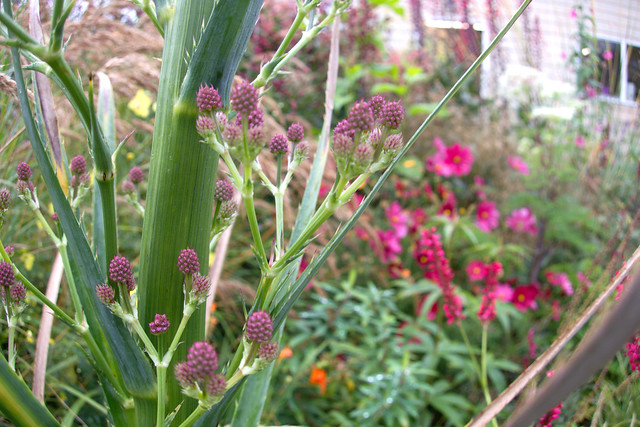Feathertop Grass, known as the least robust of the fountain grasses, is everything I want in a medium-sized fluffy grass. Admired daily, I watched how the circumference of the clump expanded and stretched into the gravel and grew more and more exceptional in every way I wanted.
But there was that mission creep. The grass was doing everything I wanted, even if it was more vigorous than expected. Not wanting to interrupt its summer flowering, I decided it could easily be divided next spring.
But this morning I reasoned there was no harm in removing some of the runners, just to be on the safe side, and there would still be plenty of plumes left. And that’s when I was confronted with how pernicious and deep the roots were, and how dangerous its presence was to this little garden, As a light rain fell, the Feathertop Grass and I battled for control. I wanted none of it left to take root again. (Frustration over glaringly obvious dangers to a healthy civic life is undoubtedly spilling over into the garden.)
I moved the pot of flowering oregano and Blue Oat Grass into the void. Goddess Flora, grant me enough self-control to not replant the area until I’m sure the Feathertop Grass is truly eradicated.
In happier news, my potted Aloe boylei, the largest-leaved of the grass aloes, is throwing a bloom. It was kept in its pot under the porch awning last winter.
This small garden can’t accommodate more than one strapping eucomis, but at least it obligingly throws a sensational flower.
Eryngium pandanifolium needed a frustrating amount of cleanup in spring, and the sprawling clump was reduced to two rosettes. Both are blooming, and I have to admit that once the onerous work is done in spring it requires no attention. Camassias are planted behind the eryngo, which may or may not work. We’ll see next spring.
Take care! AGO









The sad case of too much of a good thing. I was charmed – and interested – until I saw the dreaded words “spreads by rhizomes.” As with your delightful feathertop grass, I planted Symphotrichum chilense based on Annie’s Nursery’s statement that it was manageable in a dry climate – and then we got a couple of years of good rain and it was everywhere. I spent a good amount of time a couple of years ago digging up most of a large bed to remove it but, after a brief pause, it’s back despite this year’s lousy rainfall.
I love that Aloe!
I’m so glad you’ve discovered the “Wooly Bear” caterpillars, they’re a fav. Bye bye bad grass.
Such a beautiful, naughty grass. But you’ve had lots of experience editing your modestly-sized LB garden, so you’re in good form for keeping this one manageable. Late August is looking great in your garden, Denise!
The eryngium has an interesting flower colour. I’ve only ever seen blue or silvery blue inflorescences before. Such a cool genus. Grasses can be sneaky especially pennisetums. Good thing you dug it out as they can be real thugs and tough to eradicate.
Hmm, and me about to plant a different Pennisetum. But as you say, in a different soil and climate, it might be a different beast as I would be growing under summer dry conditions that could slow the run to a trot. Our climate certainly seems to have worked for Lobelia laxiflora, which others describe as incredibly vigorous, but has slowly increased in size to a manageable 3 foot clump over 15 or so years in our garden. That, I can manage.
It’s gorgeous, but yeah – a thug. I shy away from all those cute grasses for the same reason. Their little nodding fluffy heads appeal, but dang. I’ve not heard of Aloe boylei, what a unique bloom, love it!
@Kris, as an update, I did save some of the grass to try in really poor soil conditions. And that aloe is still showing those really pale colors as it opens, with the tips still green.
@Loree, it wouldn’t be late summer without the Wooly Bears!
@Jane, I can’t wait to hear about your new garden, modest-sized or otherwise!
@Elaine, there are selections of that eryngo with even darker flowers e.g. ‘Physic Purple.’
@Jerry, zones and soil make such a difference. Lobelia laxiflora in zone 10 was a sprawling mess.
@Tracy, it’s so nice to have an aloe in bloom up here! I hope it comes through again this winter.